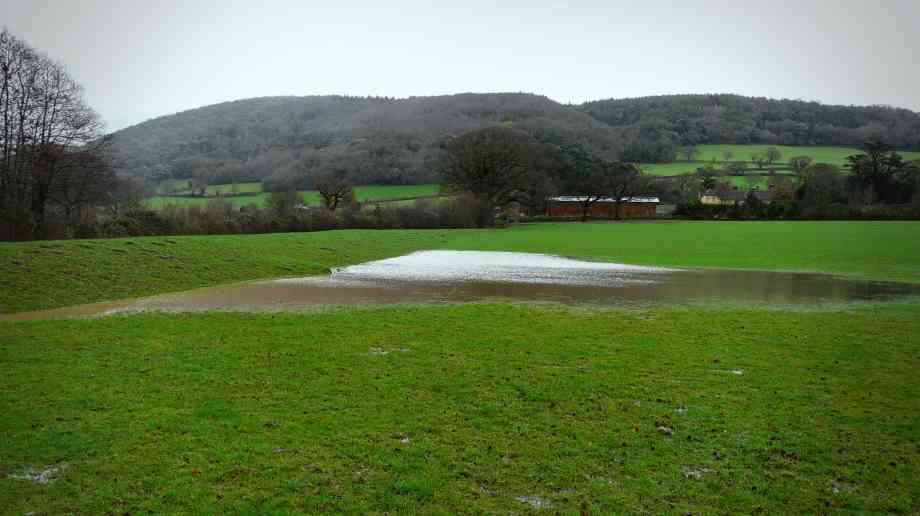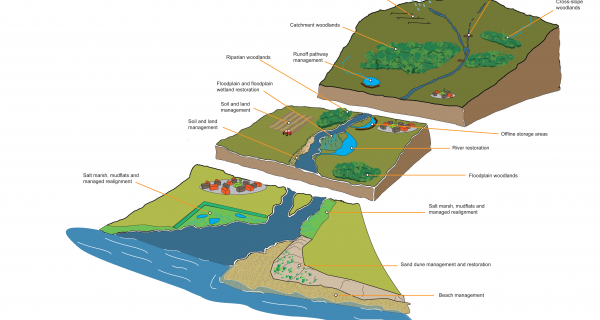Sue Robb of 4Children talks to Julie Laughton and Alison Britton from the Department for Education about the role of childminders in delivering the 30 hours free entitlement.

Natural flood management – taking it forward
Natural flood management is a popular subject these days as a potential means to help safeguard vulnerable communities. But how effective is it? And how can we take it forward? In this article, Steve Maslen explains how the system might be applied to communities at risk of flooding
At the outset in any discussion on natural flood management (NFM) it is worth noting that coastal and river flooding are ‘natural’ processes. Our conventional means of controlling these natural events, where they risk damaging property or risking life, are with walls, embankments channel straightening dredging and flood storage areas. These engineering interventions to varying degrees work against natural processes.
NFM interventions in contrast seek to work with natural processes. NFM in river catchments consists of introducing ‘natural’ measures upstream to reduce the frequency and severity of flooding. Specifically, these measures target runoff from hillslopes, river channel dynamics and flood plain storage. On the coast NFM targets the natural geomorphic and coastal processes such as waves, tides, longshore drift and cross shore currents. NFM on the coast can range from the restoration of salt marsh, shingle beaches or sand dunes in a specific location to large-scale adaptation of coastal morphology to a form that requires minimum maintenance to sustain its flood risk and coastal risk reduction functions.
What is the evidence that NFM will work?
This was a question the Environment Agency sought to answer in the two year Working with Natural Processes research to be published in October 2107.
Following the floods of summer 2007 the Pitt Review concluded that flooding can no longer be solely managed by building ever higher, lengthier and heavier defences in urban and rural areas. The review emphasised the need to ‘work with natural processes’ as part of integrated portfolios of responses to flooding and coastal erosion. It defined Working with Natural Processes (WwNP) as ‘protecting, restoring and emulating the natural regulating function of catchments, rivers, floodplains and coasts’.
In the years following the Pitt Review, Defra, the Environment Agency, NRW and SEPA recognised that as a national priority research was required which would: draw together current research on WwNP into an Evidence Base; set out the limits of our current knowledge to inform future research and also to inform the monitoring requirements for implemented projects; and provide practical tools to promote where appropriate the consideration of WwNP alongside conventional flood risk management techniques.
The research is now complete and will be published online by the Environment Agency in October 2107. As well as an Evidence Base it also includes over 60 case studies and broadscale NFM Opportunity Maps for England. The Opportunity Maps identify places where there is the potential to implement a range of NFM measures to reduce flood risks. They identify where measures such as upstream flood storage, runoff attenuation, reconnecting water courses with floodplains, flood peak attenuation through tree planting, and soil and land management improvements could be potentially effective.
The Evidence Directory and the Opportunity Maps combine to identify where and what types of NFM measure or interventions might be effective by creating temporary storage for floodwater and slowing the flow. The case studies provide practical examples of how projects have been implemented. Within each section of the Evidence Directory, users can look for individual measures to understand the science, confidence, and management of each feature. The measures are illustrated and listed below:

All the measures reviewed in the WwNP research, and which also appear in the Oxford Martin Restatement 4 (2017) review, do work in so far as at the plot or field scale each will operationally reduce runoff, create storage or slow the flow. Each could therefore contribute to reducing downstream flood risks. There is also evidence that many measures have reduced flooding at the farm and sub catchment scale. However, their wider effectiveness in managing flood risks is still not clear. It is proving difficult to demonstrate their effectiveness at the larger catchment scale. This is the stumbling block for NFM uptake.
To address this knowledge gap both Defra and NERC are continuing to support NFM initiatives and research. In July 2016, after severe and extensive flooding during the preceding winters, Defra launched a competition to highlight imaginative approaches to flood risk management. The competition, which was open to all, asked ‘if you were responsible for managing the Eden catchment in Cumbria, what flood risk management approaches would you recommend, and why?’. This question was accompanied by the release of new, open data sets to focus entries on innovative approaches alongside more established methods for reducing flood risk.
The winning entry was submitted by a JBA and Lancaster University inter-disciplinary team. The approach taken assessed flood risk in the Eden using recent advances in whole-catchment modelling and recommended a range of measures to improve flood resilience. The measures focussed on working with natural processes through distributed ‘natural’ flood risk management in the headwaters, but also included large scale flood storage in the lower catchment. It also included new innovative non-structural measures emerging from national projects. These included improved interpretations of flood warnings, interactive maps showing property-level impacts based on detailed models, and real-time event footprints.
There is no one solution to improving resilience in the Eden and larger catchments in general. The work concluded that effective NFM needs to be widespread, but also combined with multiple larger scale interventions, improved uptake of property level protection (PLP) and improvements to flood warnings and forecasting.
This work demonstrated that it is now possible to test resilience strategies rigorously by modelling catchment responses to events, with and without resilience measures, under a much wider range of realistic extreme event scenarios than has conventionally been applied.
The conclusions of the WwNP Research and of the Oxford Martin review is that NFM measures can be effective in reducing the depth, frequency and duration of small flood events in small catchments. The key phrasing here is ‘small events’. There is little evidence that NFM measures will reduce flood risk in extreme events. Some recent modelling (Life IP) points to catchment wide distributed farm run off attenuation features cumulatively potentially having an effect at the catchment scale. The research now planned by NERC over the next few years is seeking to tackle this upscaling issue and establish whether multiple interventions at the landscape scale can affect the downstream impacts
Implementing NFM
Public funding for flood risk management projects requires a demonstrable risk reduction, usually expressed as households with reduced risk of flooding or coastal erosion, and must also demonstrate a positive benefit to cost ratio. The issue for NFM projects is the immense difficulty of establishing with certainty the scale of risk reduction, the scheme benefits and the whole life costs. By contrast conventional engineered flood defence projects are not only relatively straightforward and risk-free, but the design and business case processes required for funding are also well established. As such, the conventional public funding model will need to be adjusted if we wish to promote more NFM which will require government action.
A key characteristic of NFM measures is that they deliver multiple benefits. This good fortune has led to some innovative approaches to funding NFM projects to date and has also led to huge levels of community involvement in project development and implementation. Outside conventional funding for flood risk work, NFM project funding and resources have been made available from multiple sources - from communities, from investments to deliver water quality and biodiversity enhancements and from research organisations. The potential for NFM measures to deliver water quality benefits has not gone un noticed by Water Companies and the WwNP research literature review provides good evidence on these benifits. At least one Water Company has now identified where NFM measures will deliver both flood risk and water quality benefits as part of a whole catchment approach.
The opportunities for future NFM funding to be linked to payments for land management providing a wider range of land based services are now openly talked about in organisations, such as the National Farmers Union (NFU), CLA and by politicians. This is perhaps one of the most likely ways in which NFM implementation will progress.
However public’ payment to landowners for services is a policy choice made by politicians. It is also reliant on a myriad of different landowners thinking and acting in concert. As such NFM would be subject to changes of personnel and in attitudes. Both conventional flood management measures and NFM require ongoing maintenance for them to remain effective. For NFM measures our understanding of these requirements is not yet clear and how these can be secured in the long term is a further question yet to be answered. Securing benefits from NFM in the long term is a risk for NFM which conventionally funded engineering projects do not usually carry.
The other way in which NFM can progress and is the one I would like to see develop quickly, is for it to complement conventional projects. The Defra competition work points to this approach. In these circumstances NFM measures should be accepted during project planning alongside consideration of conventional schemes. They would be part of a suite of interventions to provide long term community resilience. Introduced initially as part of a scheme and then incrementally afterwards NFM can provide a naturally adaptive approach to climate change.
If the existing funding model can be adjusted to promote NFM alongside conventional solutions then its uptake will increase significantly and it will deliver many other benefits to society and the environment besides flood risk management.
Steve Maslen is head of Environment at JBA.
Image caption: Shallow and broad earth bund on the Aller floodplain on the National Trust Holnicote Estate (West Somerset) with piped outlet to drain out stored floodwater after main flood peak has passed.
Company Focus
The Isuzu D-Max is a rugged workhorse that can fulfil a myriad of purposes as both a business and personal vehicle. Consequently, the D-Max is a particularly popular choice when it comes to farming, construction, and trade industries. Uncompromising in nature, the D-Max strives to be the ideal companion for many business needs.
Event Diary
UKREiiF has quickly become a must-attend in the industry calendar for Government departments and local authorities.
The multi-award-winning UK Construction Week (UKCW), is the UK’s biggest trade event for the built environment that connects the whole supply chain to be the catalyst for growth and positive change in the industry.
Supplier Profiles
Geo Energy
At GeoEnergy Design, we're on a mission to disrupt the traditional way heating and cooling ha
Latest Features
Professor Harith Alani, director of the Knowledge Management Institute at the Open University explains how AI can be used for good and bad.
Alex Lawrence, head of health & social care, techUK sets out techUK’s Five Point Plan for CareTech.












